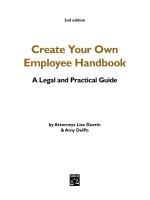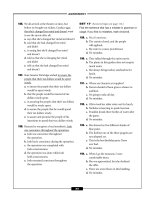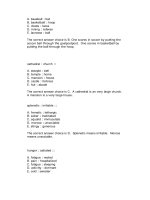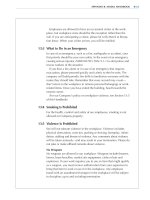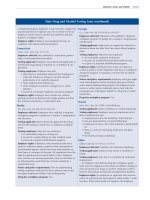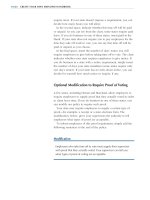create your own employee handbook a legal and practical guide phần 4 ppt
Bạn đang xem bản rút gọn của tài liệu. Xem và tải ngay bản đầy đủ của tài liệu tại đây (337.4 KB, 41 trang )
CHAPTER
8
Employee Benefits
Most employers spend a significant amount of their labor budget
on benefits for their employees. Indeed, about 40% of an average
employee’s compensation package goes toward benefits. Employers
do this with good reason. Generous employee benefits can help
you entice high quality workers, retain valuable employees and
improve labor relations. In addition, good benefits can actually
assist your employees in being more productive and effective. An
employee with health insurance is less likely to miss work due to
an untreated illness than an employee who’s worried about racking
up doctor bills, for example.
Of course, you can only reap these rewards if your employees
actually know about—and take advantage of—the benefit programs
that you offer. Too often, employers pay for benefit programs that
their employees don’t even use, because the employees either don’t
know about the program or don’t understand it. Your employee
handbook is the ideal place to acquaint your employees with their
benefits.
The handbook is not, however, the ideal place to educate your
employees about every last detail of each benefit program. This is
because benefit programs, unlike employee handbooks, tend to
change, even if only slightly, every year. If you put too much infor-
mation in your handbook, you’ll have to rewrite it every time you
need to change and adjust your benefit programs. Or if you leave
out-of-date information in your handbook, you risk having your
employees rely on that information, unaware that the benefit no
longer exists or that it has changed significantly. This could damage
labor relations (the opposite of what you want) and even leave
you vulnerable to a claim from the employee that you breached a
contract (in the form of handbook language) over the benefits that
you would offer.
As a result, most employers choose to make their handbook
descriptions of benefits quite general, leaving the details to separate
handouts and brochures that they can distribute to employees
whenever the need arises. The standard and sample policies in this
8/2 CREATE YOUR OWN EMPLOYEE HANDBOOK
chapter follow that model. They allow you to toot your own horn,
as it were, and announce how wonderful your benefits are without
binding you to the details.
The benefits that employers provide usually fall into one of two
groups: those that the employer provides voluntarily and those that
are mandated by law. Voluntary benefit programs include health
insurance, dental insurance, on-site childcare, life insurance and
retirement coverage (for example, a pension plan or a 401(k) plan).
Legally mandated benefit programs include workers’ compensation
coverage and unemployment insurance. To find out what sorts of
benefits are legally mandated in your state, contact your state labor
department. (See Appendix C for contact details.)
Your handbook should contain policies for every kind of benefit
program you offer, regardless of whether the program is voluntary
or legally mandated. In this chapter, we provide you with the
following policies:
8:1 Employee Benefits: Introductory Statement 8/3
8:2 Domestic Partner Coverage 8/5
8:3 Healthcare Benefits 8/7
8:4 Disability 8/9
8:5 Workers’ Compensation 8/10
8:6 Unemployment Insurance 8/11
EMPLOYEE BENEFITS 8/3
8:1 Employee Benefits:
Introductory Statement
As we explained above, you don’t want to pack too many details
into your benefits section because you want to maintain flexibility:
You want to be able to change the benefits at any time and you
want to avoid making promises in your handbook that you won’t
be able to keep.
This standard language maintains your flexibility to change
benefits, explains the significance of official plan documents and
tells employees where to go for more information.
Standard Policy
Employee Benefit Plans
As part of our commitment to our employees and their well-being,
[Company Name] provides employees with a variety of benefit
plans:
[List all of the voluntary and legally mandated benefit
plans that you provide—for example, health insurance, retirement
benefits, stock options, unemployment compensation, workers’
compensation].
Although we introduce you to those plans in this section, we
cannot provide the details of each plan here. You should receive
official plan documents for each of the benefit plans that we offer.
Those documents (along with any updates that we give to you)
should be your primary resource for information about your benefit
plans. If you see any conflict between those documents and the in-
formation in this Handbook, the official plan documents are what
you should rely upon.
The benefits we provide are meant to help employees maintain a
high quality of life—both professionally and personally. We sincerely
hope that each employee will take full advantage of these benefits.
If you don’t understand information in the plan documents or if you
have any questions about the benefits we offer, please talk to
.
8/4 CREATE YOUR OWN EMPLOYEE HANDBOOK
How to Complete This Policy
In addition to listing all of the benefits that you offer, you will have
to choose someone to whom employees can go for more informa-
tion about the various benefit plans. Try to pick someone in your
company—for example, an office manager or a human resources
worker—who is willing and able to get up to speed on these matters.
Don’t simply instruct employees to call the customer service numbers
at the various providers of your benefits plans. If employees are to
make the most of the benefits that you offer—and if you are to get
your money’s worth in terms of improved labor relations—you
need to have someone on site who can help employees wade
through the often confusing maze of benefits rules.
Reality Check: Don’t Forget ERISA
The word ERISA often strikes fear into the hearts of employers,
because it is the acronym for one of the most dense and confusing
federal laws on the books: The Employee Retirement Income
Security Act.
Although it has the word “retirement” in its title, ERISA does not
limit itself to retirement plans alone. In fact, the law governs the
operation of virtually all employee benefit plans and most likely
covers every benefit plan that you offer to your employees.
Among ERISA’s many rules are ones regarding the information
that employees must receive about their benefit plans. This infor-
mation includes a summary plan description, notification of any
changes to the plan and information about how to appeal any
adverse decisions made by the plan.
If you pay someone to administer a plan for you (for example, if
a health insurance company provides the healthcare coverage for
your employees), then that plan administrator will usually take care
of complying with ERISA’s requirements. Talk to your plan adminis-
trator and make sure that ERISA is being followed to the letter.
If you administer your own plan, however, that burden will fall
on you. Unless you are incredibly sophisticated and experienced in
ERISA matters, complying with ERISA is not something you can do
on your own. Seek out professional help. To learn more about
ERISA and other federal employment laws, see Federal Employment
Laws: A Desk Reference, by Amy DelPo & Lisa Guerin (Nolo.)
EMPLOYEE BENEFITS 8/5
8:2 Domestic Partner Coverage
In the past few decades, our concept of family has changed
dramatically. In 1998, only 25% of U.S. households were living in
traditional family units—husband, wife and children. What was
everyone else doing? Well, 5.9 million people were living with a
domestic partner (and 28% of those partnerships were same-sex
partnerships).
Just as our concept of family is evolving, so too is our concept
of who should be covered by an employee’s benefits. Everyone
expects a spouse and child to be eligible for coverage, but what
about the non-employee partner in a committed relationship who
either chooses to forego marriage or is legally prohibited from
marriage?
To keep up with this evolving set of norms, employers are
increasingly providing coverage for domestic partners. Deciding
whether to include domestic partner coverage is a very complicated
task, one that involves research into your state and local laws.
Some localities require domestic partners to be covered, others
prohibit it. Therefore, this is not something you can decide to do—
or not to do—based solely on your gut instinct or sense of morality.
Make this decision only after consulting with your benefits admin-
istrator and/or your lawyer.
The wording of your domestic partner policy will depend on
many things, including your state and local laws and the preferences
8/6 CREATE YOUR OWN EMPLOYEE HANDBOOK
of your benefits administrator. The following is just an example of
what such a policy might look like.
SAMPLE POLICY LANGUAGE:
At J&J Books, we recognize that some of our employees are
members of families that do not meet the traditional definition of
the word—that is, a husband, wife and, perhaps, children. For
those employees who are not married but who are in a committed
relationship with another adult, we provide domestic partnership
coverage.
To be eligible for benefits, the employee and the employee’s
partner must meet all of the following criteria:
1. They must have lived together in an exclusive committed
relationship for at least 12 months.
2. They must be at least 18 years of age.
3. They must live together in the same residence.
4. They cannot be legally married to—or in a registered
domestic partnership with—anyone else.
5. They must not be related by blood more closely than
would be allowed under the marriage laws of this state.
6. They must complete and sign a Domestic Partnership
Affidavit.
For a comprehensive guide
to domestic partner coverage,
including information on state and lo-
cal laws and advice on how to decide
whether to offer such coverage in
your own workplace, see Domestic
Partner Benefits: An Employer’s
Guide, by Joseph Adams & Todd
Solomon (Thompson Publishing
Group).
EMPLOYEE BENEFITS 8/7
8:3 Healthcare Benefits
The healthcare coverage that you offer to your employees is the
flagship of your employee benefits program. No matter what other
benefits you offer (tuition reimbursement, employee assistance
programs and the like) the most important one to your employees
will be your healthcare program. Healthcare benefits include more
than simply medical coverage. They also include any vision, dental
or similar benefits that you provide.
Because healthcare benefits have so many permutations and
options, we cannot provide you with a standard policy to place in
your handbook. We do, however, provide an example of a health-
care policy, followed by detailed guidance on how to write one of
your own.
SAMPLE POLICY LANGUAGE:
Because your health is of great importance to us, we provide you
with the following healthcare benefits: medical, dental, vision and
alternative (including acupuncture and massage). If you have not
already received detailed plan documents about each of these
benefits, contact Myrtle Means in the Human Resources Depart-
ment. She can provide you with all of the information that you
need to start enjoying your healthcare benefits package right
away. Even if you have received plan documents, Myrtle can
answer any questions you might have.
Eligibility to receive healthcare benefits depends on your
employee classification. (See Section D of this Handbook for
information about employee classifications.) If you are a regular
full-time or regular part-time employee, you are eligible to
receive full healthcare benefits, and we will pay 100 percent of
the premium for you.
And don’t worry. We haven’t forgotten about your loved ones.
We will pay 100 percent of the premium for eligible dependents
(including domestic partners).
You and your dependents become eligible for benefits 30 days
after the day you start work.
As with all of the policies in this Handbook, our healthcare
coverage may change at any time. For the most up-to-date
information about your healthcare benefits, refer to the plan
documents or contact Myrtle.
8/8 CREATE YOUR OWN EMPLOYEE HANDBOOK
What to Include in This Policy
When writing your healthcare benefits policy, it’s important to
keep in mind the advice we gave at the beginning of this chapter:
• keep the information in the handbook general and non-
specific, and
• refer employees to official plan documents for details.
That being said, there are some details that you should include
in your policy language. These details are not about the benefit
itself, but are about who is eligible for the benefit and who will
pay for it. Include the following information in your medical
benefits policy:
• The classification(s) of employees who are eligible for the
benefit (for example, regular full-time employees). (See
Chapter 5 for policy language about employee classifications.)
• The classification(s) of employees who are not eligible for
the benefit (for example, temporary employees).
• The amount of the premium that you will pay.
• The amount of the premium that the employee must pay.
•Whether dependents and/or domestic partners will be
covered.
EMPLOYEE BENEFITS 8/9
8:4 Disability
Most states require employers to withhold a portion of an employee’s
paycheck to pay for disability insurance. When employees suffer
non-work injuries that prevent them from doing their jobs, they
can receive disability benefits.
Even though money is taken out of their paychecks to pay for
this benefit, many employees do not know about or understand it.
This policy explains in general terms who is eligible for state
disability benefits and alerts employees to the difference between
disability coverage and workers’ compensation.
Standard Policy
State Disability Insurance
Sometimes, an employee suffers an illness or injury outside of the
workplace that prevents the employee from working and earning
income. If this happens to you, the state disability insurance may
provide you with a percentage of your salary while you are unable
to work. All employees are eligible for this coverage and pay for it
through deductions from their paychecks.
To find out more about state disability insurance, contact
.
If you suffer from an illness or injury that is work-related, then
you may be eligible for workers’ compensation insurance instead of
state disability insurance. See the Workers’ Compensation policy,
below, or contact
for more information.
Who Needs This Policy
If your state requires you to withhold a percentage of your
employees’ wages to fund a state disability insurance program, you
should have this policy in your handbook. Your payroll department
should know whether you are withholding disability money—or
you can contact your state department of labor (see Appendix C
for contact information).
8/10 CREATE YOUR OWN EMPLOYEE HANDBOOK
8:5 Workers’ Compensation
Most employers must carry workers’ compensation insurance to
cover them when an employee suffers a work-related injury. This
policy explains what workers’ compensation insurance is, and it
instructs employees to notify the company immediately if they are
injured or become ill. This is a very important requirement, for it
will help you prevent harm to other employees.
Standard Policy
Workers’ Compensation Insurance
If you suffer from an illness or injury that is related to your work,
you may be eligible for workers’ compensation benefits. Workers’
compensation will pay for medical care and lost wages resulting
from job-related illnesses or injuries.
If you are injured or become ill through work, please inform your
supervisor immediately regardless of how minor the injury or illness
might be.
To find out more about workers’ compensation coverage, contact
.
If you are unable to work because of an illness or injury that is
not related to work, then you might be eligible for state disability
insurance instead of workers’ compensation. See the Disability
Insurance policy, above, or contact
for more information.
Who Needs This Policy
All employers who are required by state law to provide workers’
compensation coverage must have this policy in their handbooks.
Contact your state workers’ compensation office to find out about
requirements in your state. (See Appendix C for contact details.)
EMPLOYEE BENEFITS 8/11
8:6 Unemployment Insurance
Unemployment insurance is another state-mandated benefit. Usually,
employers withhold a portion of each employee’s paycheck to
fund this insurance program, which pays benefits to employees
who suddenly find themselves out of work.
The ins and outs of who is eligible for unemployment insurance
can be rather complicated. As a result, this policy simply notifies
employees that this benefit exists, and it instructs them on whom
to contact for more information.
Standard Policy
Unemployment Insurance
If your employment with our Company ends, you may be eligible
for unemployment benefits. These benefits provide you with a
percentage of your wages while you are unemployed and looking
for work. To find out more, contact
.
Who Needs This Policy
All employers who are required by state law to provide unemploy-
ment coverage must have this policy in their handbooks. Contact
your state labor department to find out about requirements in your
state. (See Appendix C for contact details.) ■
CHAPTER
9
Use of Company Property
In virtually every workplace, employees must use company equip-
ment and property to do their jobs. This includes everything from
the $2 stapler to the $2,000 computer. Because you invest so much
money in your equipment, it makes sense to say something about
it in your handbook. There are a lot of issues to address, from
personal use to proper maintenance and safety.
In this chapter, we cover the following policies:
9:1 Use of Company Property: In General 9/2
9:2 Company Car 9/3
9:3 Telephones 9/5
9:4 Return of Company Property 9/6
9/2 CREATE YOUR OWN EMPLOYEE HANDBOOK
9:1 Use of Company Property:
In General
Regardless of the type of property or equipment, you probably
want your employees to take good care of it and use it only for
company business. Anything less would affect your pocketbook as
replacement and repair costs piled up.
The following general use policy explains to employees what
you mean by proper use, what you expect of them and why all
this matters in the first place.
Standard Policy
Company Property
We have invested a great deal of money in the property and
equipment that you use to perform your job. It is a senseless and
avoidable drain on this Company’s bottom line when people abuse
Company property, misuse it or wear it out prematurely by using it
for personal business.
We ask all employees to take care of Company property and to
report any problems to
. If a
piece of equipment or property is unsafe for use, please report it
immediately.
Please use property only in the manner intended and as instructed.
We do not allow personal use of Company property unless
specifically authorized in this Handbook.
Failure to use Company property appropriately, and failure to
report problems or unsafe conditions, may result in disciplinary
action, up to and including termination.
For information on use of the voicemail system, see Section
of this Handbook.
For information on use of computers, the Internet and software,
see Section of this Handbook.
How to Complete This Policy
Choose an individual to whom employees can report problems. At
some companies, this will simply be the employee’s supervisor.
Other companies appoint a property manager.
For policies on personal use of
the telephone and voicemail
system, see Chapter 14. For policies
on personal use of computers, software
and the Internet, see Chapter 15. For
policies on confidentiality and intel-
lectual property, see Chapter 18.
USE OF COMPANY PROPERTY 9/3
9:2 Company Car
If you provide cars for employees to drive, then you should ex-
plain in your handbook the rules for their use. You must address a
variety of issues, from maintenance to personal use.
Standard Policy
Company Cars
We have invested in Company vehicles so that our employees can
use them on Company business in place of their own vehicle. This
saves wear and tear on personal vehicles and eliminates the need
for keeping track of mileage.
We need your help in keeping Company cars in the best condition
possible. Please keep them clean, and please remove any trash or
personal items when you are finished using the vehicles.
Please immediately report any accidents, mechanical problems
or other problems to
. We will try to have
Company vehicles repaired or serviced as soon as possible.
Only authorized employees may use Company cars, and they
may do so only on Company business.
You may not use Company vehicles while under the influence of
drugs or alcohol or while otherwise impaired.
You must have a valid driver’s license to use Company cars, and
we expect that you will drive in a safe and courteous manner. If
you receive any tickets for parking violations or moving violations,
you are responsible for taking care of them.
Violating this policy in any way may result in disciplinary action,
up to and including termination.
Optional Modification for Employees With
Assigned Cars
At some workplaces, the company car is not simply a vehicle that
the employee checks out for a few hours while attending some
event off site. In these workplaces (often in places where employees
are salespeople who are almost constantly on the road), employees
are assigned a company car on a more or less permanent basis. For
9/4 CREATE YOUR OWN EMPLOYEE HANDBOOK
as long as the employee works for the company, the employee is
in possession of the car and uses it for all business.
In such a situation, employers often place on the employee’s
shoulders the responsibility for maintaining the car. If you are in
such a workplace, make the following modification the second to
the last paragraph of the standard policy, above.
Modification
If you have been assigned a Company car, it is your responsibility
to keep the car in good condition and repair. At a minimum, this
means keeping the car clean, bringing it in for scheduled mainte-
nance by an authorized service department and checking and
changing the oil on schedule. Periodically, we may inform you of
other ways in which you must care for the car. We will, of course,
reimburse you for any ordinary expenses associated with maintain-
ing the vehicle.
USE OF COMPANY PROPERTY 9/5
9:3 Telephones
It’s a good idea to let employees know that you expect them to
use work phones for company business only, except in case of
emergencies or quick calls. It isn’t reasonable to prohibit all personal
calls, as long as they are brief and infrequent—certainly you can
allow an employee to tell a spouse that she’ll be home late or to
make sure that his kids made it home from school. But without a
policy limiting personal calls, some employees will inevitably take
advantage.
Standard Policy
Telephone System
The Company’s telephone system is for business use only. Employees
are expected to keep personal calls to a minimum. If you must make
or receive a personal call, please keep your conversation brief. Ex-
tensive personal use of Company phones is grounds for discipline.
See Section
of this Handbook for information on privacy and
telephones.
9/6 CREATE YOUR OWN EMPLOYEE HANDBOOK
9:4 Return of Company Property
No employment relationship lasts forever, and when an employee
leaves—whether through termination, layoff or resignation—one of
the loose ends to tie up is company property.
Standard Policy
Return of Company Property
When your employment with this Company ends, we expect you to
return Company property—and to return it clean and in good re-
pair. This includes this Employee Handbook, all manuals and
guides, documents, phones, computers, equipment, keys and tools.
We reserve the right to take any lawful action to recover or
protect our property.
Optional Modification to Garnish Final Paycheck
Some states allow for employers to garnish an employee’s final
paycheck to pay for lost, stolen or damaged company property.
Other states expressly do not allow employers to do this. To find
out whether your state allows garnishment, contact your state labor
department. (See Appendix C for contact details.)
If you live in a state that allows garnishment, consider substituting
the following paragraph for the last paragraph in the standard
policy, above:
Modification
If you do not return a piece of property, we will withhold from your
final paycheck the cost of replacing that piece of property. If you
return a piece of property in disrepair, we will withhold from your
final paycheck the cost of repair. We also reserve the right to take
any other lawful action necessary to recover or protect our property.
■
Leave and Time Off
We can all agree that a little time off is a good thing. Your workers
get a chance to have fun, deal with personal, civic and family
obligations and recharge their batteries. And your company benefits,
too—your business will be more productive if your employees are
healthy, rested and focused on their jobs.
Although many employers believe otherwise, no law requires
you to offer your employees paid vacation or sick leave (although
California recently passed a law to require paid sick leave in
certain circumstances, which will go into effect in July, 2004). By
now, however, it’s a nationwide standard. And you may be legally
required to let your employees take unpaid leave, in certain cir-
cumstances. No matter what type of leave program you decide to
adopt, the policies in this chapter will help you set rules that are
consistent, sensible and easy to follow.
In this chapter, we cover the following policies:
10:1 Vacation 10/2
10:2 Holidays 10/5
10:3 Sick Leave 10/7
10:4 Paid Time Off 10/10
10:5 Family and Medical Leave 10/14
10:6 Bereavement Leave 10/19
10:7 Military Leave 10/20
10:8 Time Off to Vote 10/23
10:9 Jury Duty 10/25
CHAPTER
10
10/2 CREATE YOUR OWN EMPLOYEE HANDBOOK
10:1 Vacation
Most employers offer paid vacation benefits to at least some of
their employees, even though they aren’t legally required to do so.
Paid vacation has become a standard business practice in this
country—employers who don’t offer some paid days off for rest
and relaxation will almost certainly have trouble attracting and
retaining good employees.
Your vacation policy should explain who is eligible for vacation,
how vacation time accrues and how the employee can schedule
time off.
Standard Policy
Vacation
Our Company recognizes that our employees need to take time off
occasionally, to rest and relax, to enjoy a vacation or to attend to
personal matters. That’s why we offer a paid vacation program.
employees are eligible to participate
in the paid vacation program.
Eligible employees accrue vacation time according to the follow-
ing schedule:
[insert schedule here]
Employees must schedule their vacations in advance, with their
supervisor. We will try to grant every employee’s vacation request
for the days off of their choice. However, we must have enough
workers to meet our day-to-day needs—which means we might not
be able to grant every vacation request, especially during holiday
periods.
How to Complete This Policy
In the first blank space, indicate which employees will be eligible
to participate in the vacation program. Some employers limit these
benefits to full-time employees or require employees to complete a
waiting period before they can accrue or use benefits. For informa-
tion and policies on these employee classifications, see Chapter 5.
In the second blank, write in the schedule by which employees
will accrue benefits. Many employers provide increases in benefits
LEAVE AND TIME OFF 10/3
Use it or lose it policies are
illegal in some states. An
employer is legally entitled to cap
how much vacation time an
employee can accrue. However,
some states forbid “use it or lose it”
policies, by which an employee
would have to forfeit accrued but
unused vacation time over a certain
limit or past a certain date. Because
these states view earned vacation
time as a form of compensation,
which must be cashed out when the
employee quits or is fired, a policy
that takes vacation time away is seen
as an illegal form of failing to pay em-
ployees money that they have already
earned. Although the difference may
seem merely technical, an accrual
cap is legal in these states because it
prohibits the employee from earning
vacation time in the first place, rather
than taking away vacation time after
the employee has earned it. Contact
your state labor department to find
out about your state’s rules (see Ap-
pendix C for contact information).
to employees who stay with the company over time. For example,
a worker might accrue ten days of vacation during the first year or
two of employment, then move up to 15 the next year, then 20.
Once you figure out how many days of vacation employees will
accrue, divide that number by 12 to figure out how many days of
vacation they accrue each month.
SAMPLE POLICY LANGUAGE: Here is an accrual schedule that al-
lows employees to accrue ten days of vacation during their first
and second years of employment, 15 the third and fourth years
and 20 thereafter:
Years of Employment Vacation Accrual
0-2 10 days per year, at the rate
of
5
/6 of a day per month
2-4 15 days per year, at the rate
of 1
1
/4 days per month
4 or more 20 days per year, at the rate
of 1
2
/3 days per month
Optional Modifications
To Cap Accrual of Vacation Time
You can encourage your employees to use their vacation regularly—
and avoid having employees out for months of collected vacation
at a time—by capping how much vacation time your employees
can accrue. Employees who reach this limit won’t earn any more
vacation time until they take some vacation and bring themselves
back down below the cap. To cap how much vacation time an
employee can accrue, add this modification immediately following
the accrual schedule. In the blank space, insert the cap—how
many hours or days of vacation time an employee will be allowed
to accrue.
Modification
Employees may not accrue more than of vacation time.
Once an employee’s vacation balance reaches this limit, an
employee may accrue more vacation only by taking some vacation
time to bring the employee’s balance back below the limit.
10/4 CREATE YOUR OWN EMPLOYEE HANDBOOK
To Pay Unused Vacation at Termination
Some states require employers to cash out unused, accrued vacation
time when an employee quits or is fired. You can find out your
state’s rule by checking the chart “State Laws That Control Final
Paychecks,” at the end of Chapter 21. If you do business in a state
that requires you to pay unused vacation, you might consider
modifying the policy to inform employees that they will receive
payment for unused vacation. To do so, simply add the modification
below as the final paragraph of the policy:
Modification
Employees will be paid for any accrued and unused vacation when
their employment terminates.
LEAVE AND TIME OFF 10/5
10:2 Holidays
Most companies offer their employees paid time off on certain
holidays, such as New Year’s Day, Independence Day and Thanks-
giving. Your holiday policy should tell employees what holidays
the company observes and what happens when a holiday falls on
a weekend.
Standard Policy
Holidays
Our Company observes the following holidays each year:
[list]
.
If a holiday falls on a weekend, the Company will inform you
when the holiday will be observed. Ordinarily, holidays falling on a
Saturday will be observed the preceding Friday; holidays falling on
a Sunday will be observed the following Monday.
How to Complete This Policy
In the blank space, list the holidays your company will observe.
The days you choose will, of course, depend on when your business
is open. Most employers offer some combination of the following:
New Year’s Day, Martin Luther King Day, President’s Day, Good
Friday, Memorial Day, Independence Day, Labor Day, Columbus
Day, Veterans’ Day, Thanksgiving, the Friday following Thanksgiving,
Christmas Eve, Christmas Day and New Year’s Eve.
Optional Modification to Allow Floating Holidays
Some of your employees may not observe the religious holidays
you choose to offer—for example, Christmas or Good Friday—and
may wish to take a holiday on a day of significance to their own
religion. You are legally obligated to accommodate your workers’
religious observations, which in some cases may require you to
give these workers time off for important religious holidays. Rather
10/6 CREATE YOUR OWN EMPLOYEE HANDBOOK
than requiring your workers to come to you with these requests,
you can make floating holidays available to all of your workers, to
allow them to participate in religious activities or attend to other
personal matters.
Some employers offer only one or two floating holidays per year;
others offer more floating holidays, but trim the list of company-
recognized holidays accordingly. If you wish to offer floating
holidays, add the modification below as the second paragraph of
the policy, immediately after the list of holidays your company
observes. In the blank, insert the number of floating holidays you
will allow your employees to take each year.
Modification
Eligible employees are also entitled to take floating holidays
each year. These holidays may be used to observe a religious
holiday, to celebrate your birthday or simply to take a day off for
personal reasons. You must schedule your floating holidays with
your supervisor in advance. If you do not use your floating holidays
during the year, you may not carry them over to the next year.
LEAVE AND TIME OFF 10/7
10:3 Sick Leave
Although employers are not legally required to provide paid sick
days, it’s common practice to do so. And there are sound reasons
to offer paid days off for workers who are ill—it will help your
workers who live paycheck to paycheck make ends meet, it will
create fewer payroll hassles and, perhaps most importantly, it will
encourage sick workers to stay home rather than coming to work
to infect the rest of your workforce or perform at a substandard
level.
Your sick leave policy should explain who is eligible for leave,
how much leave employees can take and any notice requirements
you wish to impose.
Standard Policy
Sick Leave
Our Company provides paid sick days to
. (For information on employee classifications,
see Section
of this Handbook.) Eligible employees accrue
sick days per year at the rate of per month. The
Company will not pay employees for sick days that have accrued
but have not been used when employment ends.
Employees may use sick leave when they are unable to work due
to illness or injury. Sick leave is not to be used as extra vacation
time, personal days or “mental health” days. Any employee who
abuses sick leave may be subject to discipline.
You must report to your supervisor if you will need to take sick
leave. We ask that employees call in as soon as they realize that
they will be unable to work, before the regular start of their work
day. You must report to your supervisor by phone each day you are
out on leave.
How to Complete This Policy
In the first blank, indicate who is eligible for paid sick leave. Some
employers only provide sick days to certain employees—for example,
only full-time employees, only full-time employees and part-timers
who work at least a minimum number of hours per week or only

